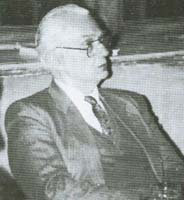 Ernst
Zündel Replies:
Ernst
Zündel Replies:Rebuttal # 40:
 Ernst
Zündel Replies:
Ernst
Zündel Replies:Many Jewish survivors of the "death camps" say they saw bodies
being piled up in pits and burned. How much gasoline would have to be used
to perform this?
First thing that needs to be mentioned with this regard is that the aerial
photographs of Auschwitz made by the US Air Force in 1943 and '44 do not
reveal any signs of any pits, no mounds of earth that would have to be
excavated from those pits, nothing that might indicate mass homicidal activity,
no smoke from crematoria, no signs of bodies being burned in the open,
no piles of  coal
- nothing! Those overflights were taking place at random, at the time when
the "extermination program" at Auschwitz was allegedly in full
swing.
coal
- nothing! Those overflights were taking place at random, at the time when
the "extermination program" at Auschwitz was allegedly in full
swing.
Those aerial photographs were extensively studied by researchers. German
historian Udo Walendy, who as a court-recognized expert was a witness
at the Zundel trial, devoted his entire "Historical Facts" magazine
(#9, 1981) to the subject.
Other expert witnesses at Zundel trials
were also giving their evidence on the subject. There is simply nothing
on those photographs to give the slightest amount of ammunition to the
holocaust writers.
The major source for the stories about "cremation pits", as well
as other ones of the same "quality", seems to be a former Auschwitz
inmate, Filip Muller, but stories of burning bodies in pits can also be
found in Auschwitz commandants' Rudolf Hoess
"confessions" and "memoirs". The stories of burning
in pits usually involve Auschwitz-Birkenau camp, but some pit burning is
also alleged at Treblinka.
The type of fuel in case of Birkenau was supposed to have been wood, not
gasoline. At Treblinka rubbish was supposedly used, which is simply preposterous,
as the rubbish of a camp is not nearly the same as that of an average American
or Canadian household.
The camps sure did not have plenty of fancy wrappings made of paper and
plastic. They probably did not have many cardboard boxes either. Every
wartime scrap of material was saved and recycled - even then! And in "paper-poor"
wartime Germany, there certainly were no newspapers with some hundred or
even twice that many pages every day, no magazines, no clothing to throw
out. It is simply inconceivable that someone would be suggesting that the
camp garbage was just as combustible as our garbage today!
As for the claims with regard to gasoline, everybody must have seen corpses
of Goebbels and Hitler. They were still far from the stage when the body
is reduced to ashes, even after a considerable amount of gasoline poured
on them. In his testimony Ivan Lagace said that he had seen the remains
of victims of crime, after the murderers had attempted to burn the corpse
with gasoline in an open area and set them on fire. They utterly failed
in that.
Human bodies are very difficult to burn, and in the open it is pretty much
impossible. Skin can be charred quite easily; limbs can also be burned;
but it is extremely difficult to cremate the torso.
The recent case in Britain involving "mad cow" disease is a case
in point. It was a real disaster of national proportions - not just for
the purely economic impact due to the loss of so much livestock, but also
for the expense associated with disposing of so many carcasses.
Somehow nobody suggested to pile those carcasses in the open and douse
them with gasoline!
And yet, according to the holocaust historiography, those "evil nazis"
in fuel-starved wartimes somehow were able to do essentially the same with
no apparent problem.
Gasoline was a very precious commodity in Germany during the war, it is
simply inconceivable that it would have been wasted on cremations of bodies,
especially for such inefficient process as burning in the open - or worse
yet, in pits! Here we do not even need to mention the fact that there is
no record of any large quantity gasoline deliveries to Auschwitz.